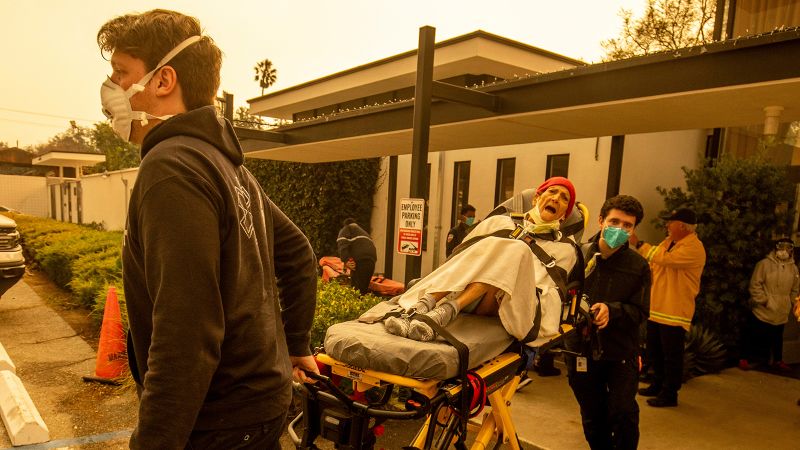“`html

Fact Check Analysis: Do Southern California Wildfires Leave Families in Limbo While Agencies Provide Questionable Relief?
As part of DBUNK LLC’s mission to expose misinformation and provide clarity for users, one of our dedicated subscribers flagged the CNN article titled
“Evacuation fatigue’ sets in for Southern Californians yet to return home after wildfires” for a closer evaluation. With claims about prolonged displacement, strained resources, and delayed recovery efforts, we delved into the accuracy of this report to uncover misinformation, missing context, and bias. Here’s what we found.
Key Findings
While the article seeks to shed light on the hardships families face after fire evacuations, such as those experienced by the Rojas and Martin households, it contains several instances of incomplete information, questionable framing, and a lack of evidentiary depth. As always, DBUNK has investigated to verify claims, fill contextual gaps, and highlight nuances that the original piece overlooked.

Misinformation: Incomplete Data About Insurance Company Effectiveness
The article mentions that Pedro Rojas “has been trying to get temporary housing through his insurance company” but does not clarify the efficacy or responsiveness of these companies. This statement leaves readers with the impression of inefficiency without providing corroborating data or comparisons to industry standards. For a fact-based narrative, CNN should have stated whether insurance delays were caused by logistical bottlenecks (e.g., volume of claims) or systemic inefficiencies. According to California’s Department of Insurance, insurers are mandated to expedite housing assistance for policyholders after wildfires (with timelines ranging from days to a few weeks). CNN neglects these standards, which leaves readers questioning without resolution.
For a balanced report, data such as average response times from major insurance firms and anecdotal examples from families like the Rojas’ should have been included.
Missing Context: Government Assistance in Displacement
CNN accurately notes that families like the Martins and Bojanovics face extended displacement, but fails to provide statistical insight into the role of state or federal programs in disaster recovery. There is a brief mention of FEMA assistance and Governor Newsom’s foreclosure protections, but this is insufficient to paint a clear picture. How many Californians currently qualify for FEMA housing? How many families received aid in past disasters like the Camp Fire or Maui wildfires? This critical information is omitted.
For example, the Federal Emergency Management Agency offers Transitional Sheltering Assistance (TSA) after federally declared disasters. Yet, CNN doesn’t specify whether families featured in the article applied for or were eligible for TSA support. Omitting this leaves the audience to assume government help is limited without fully understanding its scope or limitations.

Imbalanced Perspective: Overlooking Emotional vs. Financial Focus
While the plight of displaced families amidst the devastation of wildfires is compelling, CNN’s interviewees—Pedro Rojas, Eric Martin, and Ryan Bojanovic—point disproportionately to personal grief and frustrations. This emphasis evokes emotion but sidesteps legal and economic accountability. For instance, the article does not explore whether there were missteps in evacuation warnings, failures in fire prevention strategies, or inadequate utility company precautions (e.g., faulty PG&E equipment played a part in the infamous Camp Fire).
Further accountability measures—both governmental and corporate—are crucial for assessing wildfire recovery ecosystems, but CNN relegates such discussions to the sidelines.
Though CNN consulted multiple experts, including Crystal Kolden, a wildfire researcher, there was also inadequate balance between personal anecdotes and overarching systemic failures, which would offer a fuller representation of the issue.

Broader Context: Insurance and Government Efficacy in Rebuilding Efforts
To address the question submitted by our user: “How effective are insurance companies and government agencies in helping displaced families like the Rojas and Martin households rebuild their lives?”—the effectiveness varies significantly based on prior legislative actions, disaster preparedness, and corporate protocols.
For instance, post-2018 Camp Fire, FEMA allocated billions in individual assistance, but inconsistent applications, bureaucracy, and fraudulent claim disputes slowed the process. Similarly, the California FAIR Plan—designed to provide insurance to high-risk households—has seen average payout delays stretch due to processing issues, underscoring broader systematic inefficiencies.
CNN would have benefited from more rigorous investigation into these dynamics, making it clear where insurance companies and public programs succeed and fail. By focusing solely on individual anguish without broader systemic context, readers are left questioning the reliability of these institutions.
Your Role in Fighting Misinformation
At DBUNK LLC, we work tirelessly to ensure you have access to clear, fact-based analyses of the news. Articles like CNN’s on wildfire evacuees reflect the growing importance of investigative journalism in combatting misinformation, misrepresentation, and incomplete narratives. Our app launches soon, but you can already join the mission to stay informed and debunk the noise—because the truth matters, no matter which side of the aisle you’re on.
Start your journey with DBUNK today and break free from the frustrations of misinformation. Read the original CNN article here, and submit your own fact check request for free!

“`

